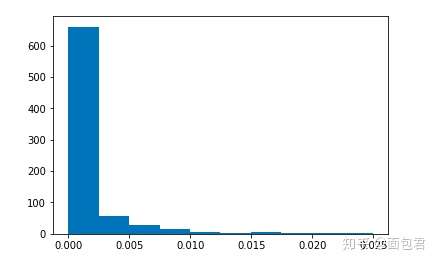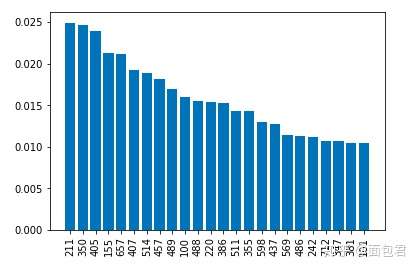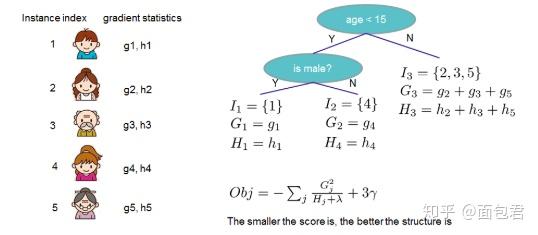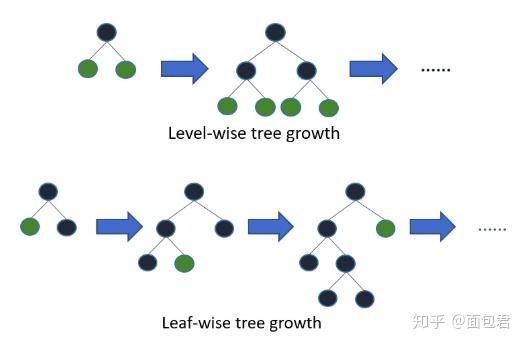Mnist数据集识别
使用Sklearn的GBDT
import gzip
import pickle as pkl
from sklearn.model_selection import train_test_split
def load_data(path):
f = gzip.open(path, 'rb')
try:
#Python3
train_set, valid_set, test_set = pkl.load(f, encoding='latin1')
except:
#Python2
train_set, valid_set, test_set = pkl.load(f)
f.close()
return(train_set,valid_set,test_set)
path = 'mnist.pkl.gz'
train_set,valid_set,test_set = load_data(path)
Xtrain,_,ytrain,_ = train_test_split(train_set[0], train_set[1], test_size=0.9)
Xtest,_,ytest,_ = train_test_split(test_set[0], test_set[1], test_size=0.9)
print(Xtrain.shape, ytrain.shape, Xtest.shape, ytest.shape)
(5000, 784) (5000,) (1000, 784) (1000,)
参数说明:
learning_rate: The learning parameter controls the magnitude of this change in the estimates. (default=0.1)
n_extimators: The number of sequential trees to be modeled. (default=100)
max_depth: The maximum depth of a tree. (default=3)
min_samples_split: Tthe minimum number of samples (or observations) which are required in a node to be considered for splitting. (default=2)
min_samples_leaf: The minimum samples (or observations) required in a terminal node or leaf. (default=1)
min_weight_fraction_leaf: Similar to min_samples_leaf but defined as a fraction of the total number of observations instead of an integer. (default=0.)
subsample: The fraction of observations to be selected for each tree. Selection is done by random sampling. (default=1.0)
max_features: The number of features to consider while searching for a best split. These will be randomly selected. (default=None)
max_leaf_nodes: The maximum number of terminal nodes or leaves in a tree. (default=None)
min_impurity_decrease: A node will be split if this split induces a decrease of the impurity greater than or equal to this value. (default=0.)
from sklearn.ensemble import GradientBoostingClassifier
import numpy as np
import time
clf = GradientBoostingClassifier(n_estimators=10,
learning_rate=0.1,
max_depth=3)
# start training
start_time = time.time()
clf.fit(Xtrain, ytrain)
end_time = time.time()
print('The training time = {}'.format(end_time - start_time))
# prediction and evaluation
pred = clf.predict(Xtest)
accuracy = np.sum(pred == ytest) / pred.shape[0]
print('Test accuracy = {}'.format(accuracy))
The training time = 11.989675521850586
Test accuracy = 0.825
集成算法可以得出特征重要性,说白了就是看各个树使用特征的情况,使用的多当然就重要了,这是分类器告诉我们的。
%matplotlib inline
import matplotlib.pyplot as plt
plt.hist(clf.feature_importances_)
print(max(clf.feature_importances_), min(clf.feature_importances_))
0.0249318971528 0.0

一般情况下,我们还可以筛选一下。
from collections import OrderedDict
d = {}
for i in range(len(clf.feature_importances_)):
if clf.feature_importances_[i] > 0.01:
d[i] = clf.feature_importances_[i]
sorted_feature_importances = OrderedDict(sorted(d.items(), key=lambda x:x[1], reverse=True))
D = sorted_feature_importances
rects = plt.bar(range(len(D)), D.values(), align='center')
plt.xticks(range(len(D)), D.keys(),rotation=90)
plt.show()

由于是像素点,所以看的没那么直观,正常特征看起来其实蛮直接的。
XGBoost
加入了更多的剪枝策略和正则项,控制过拟合风险。传统的GBDT用的是CART,Xgboost能支持的分类器更多,也可以是线性的。GBDT只用了一阶导,但是xgboost对损失函数做了二阶的泰勒展开,并且还可以自定义损失函数。

import xgboost as xgb
import numpy as np
import time
# read data into Xgboost DMatrix format
dtrain = xgb.DMatrix(Xtrain, label=ytrain)
dtest = xgb.DMatrix(Xtest, label=ytest)
# specify parameters via map
params = {
'booster':'gbtree', # tree-based models
'objective': 'multi:softmax',
'num_class':10,
'eta': 0.1, # Same to learning rate
'gamma':0, # Similar to min_impurity_decrease in GBDT
'alpha': 0, # L1 regularization term on weight (analogous to Lasso regression)
'lambda': 2, # L2 regularization term on weights (analogous to Ridge regression)
'max_depth': 3, # Same as the max_depth of GBDT
'subsample': 1, # Same as the subsample of GBDT
'colsample_bytree': 1, # Similar to max_features in GBM
'min_child_weight': 1, # minimum sum of instance weight (Hessian) needed in a child
'nthread':1, # default to maximum number of threads available if not set
}
num_round = 10
# start training
start_time = time.time()
bst = xgb.train(params, dtrain, num_round)
end_time = time.time()
print('The training time = {}'.format(end_time - start_time))
# get prediction and evaluate
ypred = bst.predict(dtest)
accuracy = np.sum(ypred == ytest) / ypred.shape[0]
print('Test accuracy = {}'.format(accuracy))
The training time = 13.496984481811523
Test accuracy = 0.821
LightGBM
放到最后肯定有一堆优点的:
- 更快的训练效率
- 低内存使用
- 更好的准确率
- 支持并行学习
- 可处理大规模数据
它摒弃了现在大部分GBDT使用的按层生长(level-wise)的决策树生长策略,使用带有深度限制的按叶子生长(leaf-wise)的策略。level-wise过一次数据可以同时分裂同一层的叶子,容易进行多线程优化,也好控制模型复杂度,不容易过拟合。但实际上level-wise是一种低效的算法,因为它不加区分的对待同一层的叶子,带来了很多没必要的开销,因为实际上很多叶子的分裂增益较低,没必要进行搜索和分裂。
Leaf-wise则是一种更为高效的策略,每次从当前所有叶子中,找到分裂增益最大的一个叶子,然后分裂,如此循环。因此同Level-wise相比,在分裂次数相同的情况下,Leaf-wise可以降低更多的误差,得到更好的精度。Leaf-wise的缺点是可能会长出比较深的决策树,产生过拟合。因此LightGBM在Leaf-wise之上增加了一个最大深度的限制,在保证高效率的同时防止过拟合。

import lightgbm as lgb
train_data = lgb.Dataset(Xtrain, label=ytrain)
test_data = lgb.Dataset(Xtest, label=ytest)
# specify parameters via map
params = {
'num_leaves':31, # Same to max_leaf_nodes in GBDT, but GBDT's default value is None
'max_depth': -1, # Same to max_depth of xgboost
'tree_learner': 'serial',
'application':'multiclass', # Same to objective of xgboost
'num_class':10, # Same to num_class of xgboost
'learning_rate': 0.1, # Same to eta of xgboost
'min_split_gain': 0, # Same to gamma of xgboost
'lambda_l1': 0, # Same to alpha of xgboost
'lambda_l2': 0, # Same to lambda of xgboost
'min_data_in_leaf': 20, # Same to min_samples_leaf of GBDT
'bagging_fraction': 1.0, # Same to subsample of xgboost
'bagging_freq': 0,
'bagging_seed': 0,
'feature_fraction': 1.0, # Same to colsample_bytree of xgboost
'feature_fraction_seed': 2,
'min_sum_hessian_in_leaf': 1e-3, # Same to min_child_weight of xgboost
'num_threads': 1
}
num_round = 10
# start training
start_time = time.time()
bst = lgb.train(params, train_data, num_round)
end_time = time.time()
print('The training time = {}'.format(end_time - start_time))
# get prediction and evaluate
ypred_onehot = bst.predict(Xtest)
ypred = []
for i in range(len(ypred_onehot)):
ypred.append(ypred_onehot[i].argmax())
accuracy = np.sum(ypred == ytest) / len(ypred)
print('Test accuracy = {}'.format(accuracy))
The training time = 4.891559839248657
Test accuracy = 0.902
结果对比
| | time(s) | accuracy(%) | |----------|---------|-------------| | GBDT | 11.98 | 0.825 | | XGBoost | 13.49 | 0.821 | | LightGBM | 4.89 | 0.902 |
http://lightgbm.apachecn.org/cn/latest/Parameters-Tuning.html